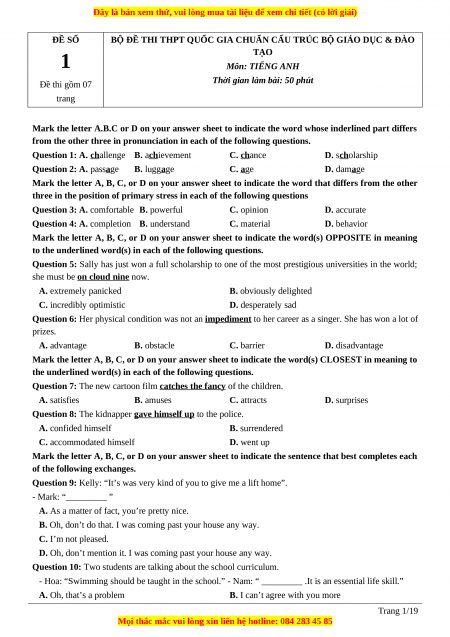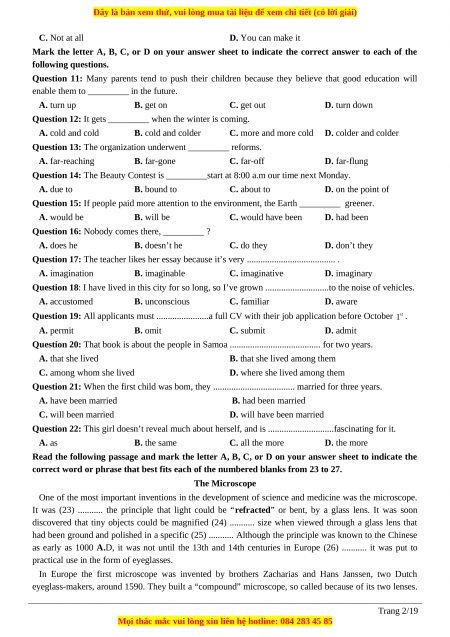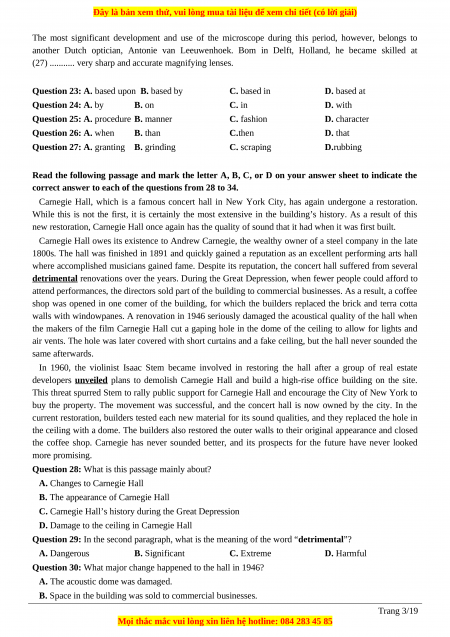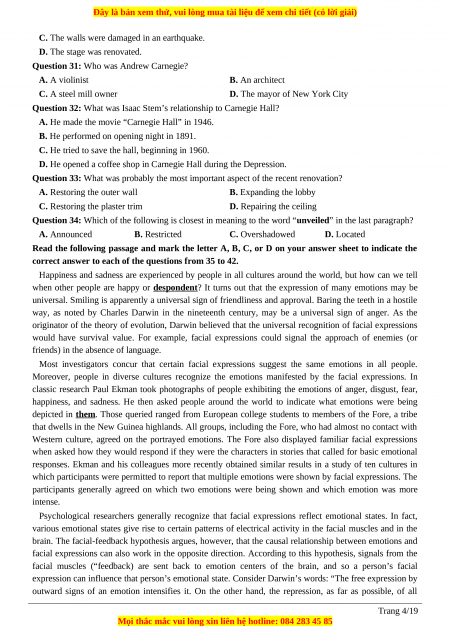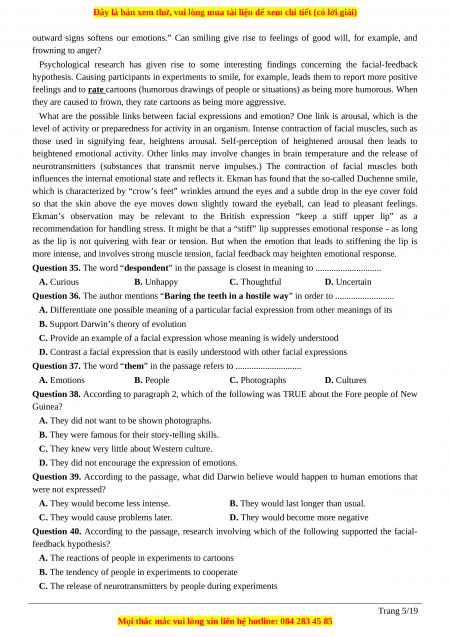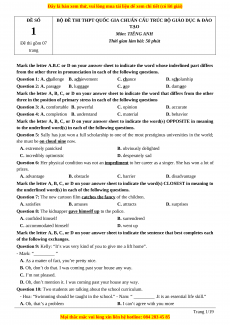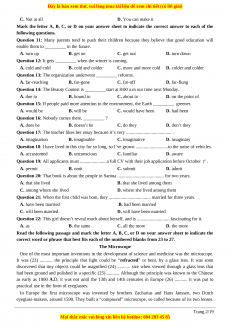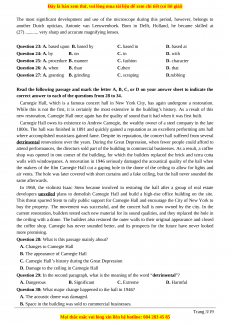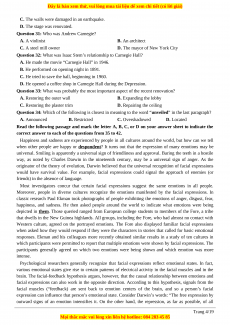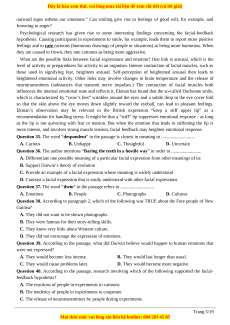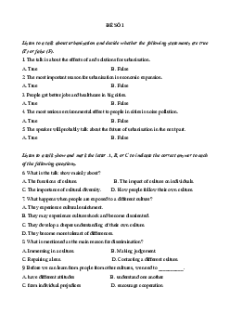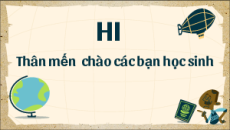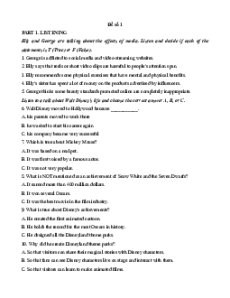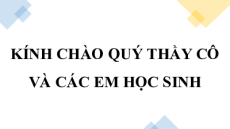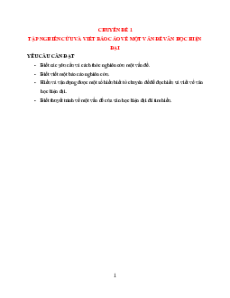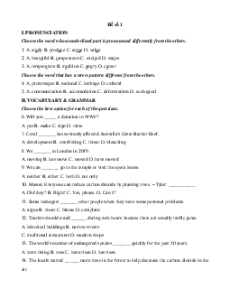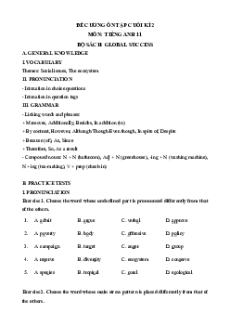ĐỀ SỐ
BỘ ĐỀ THI THPT QUỐC GIA CHUẨN CẤU TRÚC BỘ GIÁO DỤC & ĐÀO 1 TẠO
Môn: TIẾNG ANH Đề thi gồm 07
Thời gian làm bài: 50 phút trang
Mark the letter A.B.C or D on your answer sheet to indicate the word whose inderlined part differs
from the other three in pronunciation in each of the following questions.
Question 1: A. challenge B. achievement C. chance D. scholarship
Question 2: A. passage B. luggage C. age D. damage
Mark the letter A, B, C, or D on your answer sheet to indicate the word that differs from the other
three in the position of primary stress in each of the following questions
Question 3: A. comfortable B. powerful C. opinion D. accurate
Question 4: A. completion B. understand C. material D. behavior
Mark the letter A, B, C, or D on your answer sheet to indicate the word(s) OPPOSITE in meaning
to the underlined word(s) in each of the following questions.
Question 5: Sally has just won a full scholarship to one of the most prestigious universities in the world;
she must be on cloud nine now. A. extremely panicked B. obviously delighted
C. incredibly optimistic D. desperately sad
Question 6: Her physical condition was not an impediment to her career as a singer. She has won a lot of prizes. A. advantage B. obstacle C. barrier D. disadvantage
Mark the letter A, B, C, or D on your answer sheet to indicate the word(s) CLOSEST in meaning to
the underlined word(s) in each of the following questions.
Question 7: The new cartoon film catches the fancy of the children. A. satisfies B. amuses C. attracts D. surprises
Question 8: The kidnapper gave himself up to the police. A. confided himself B. surrendered
C. accommodated himself D. went up
Mark the letter A, B, C, or D on your answer sheet to indicate the sentence that best completes each of the following exchanges.
Question 9: Kelly: “It’s was very kind of you to give me a lift home”. - Mark: “_________ ”
A. As a matter of fact, you’re pretty nice.
B. Oh, don’t do that. I was coming past your house any way. C. I’m not pleased.
D. Oh, don’t mention it. I was coming past your house any way.
Question 10: Two students are talking about the school curriculum.
- Hoa: “Swimming should be taught in the school.” - Nam: “ _________ .It is an essential life skill.”
A. Oh, that’s a problem
B. I can’t agree with you more Trang 1/19
C. Not at all D. You can make it
Mark the letter A, B, C, or D on your answer sheet to indicate the correct answer to each of the following questions.
Question 11: Many parents tend to push their children because they believe that good education will
enable them to _________ in the future. A. turn up B. get on C. get out D. turn down
Question 12: It gets _________ when the winter is coming. A. cold and cold B. cold and colder
C. more and more cold D. colder and colder
Question 13: The organization underwent _________ reforms. A. far-reaching B. far-gone C. far-off D. far-flung
Question 14: The Beauty Contest is _________start at 8:00 a.m our time next Monday. A. due to B. bound to C. about to D. on the point of
Question 15: If people paid more attention to the environment, the Earth _________ greener. A. would be B. will be C. would have been D. had been
Question 16: Nobody comes there, _________ ? A. does he B. doesn’t he C. do they D. don’t they
Question 17: The teacher likes her essay because it’s very ....................................... . A. imagination B. imaginable C. imaginative D. imaginary
Question 18: I have lived in this city for so long, so I’ve grown ............................to the noise of vehicles. A. accustomed B. unconscious C. familiar D. aware
Question 19: All applicants must .......................a full CV with their job application before October . A. permit B. omit C. submit D. admit
Question 20: That book is about the people in Samoa ........................................ for two years. A. that she lived
B. that she lived among them
C. among whom she lived
D. where she lived among them
Question 21: When the first child was bom, they .................................... married for three years. A. have been married B. had been married C. will been married
D. will have been married
Question 22: This girl doesn’t reveal much about herself, and is .............................fascinating for it. A. as B. the same C. all the more D. the more
Read the following passage and mark the letter A, B, C, or D on your answer sheet to indicate the
correct word or phrase that best fits each of the numbered blanks from 23 to 27. The Microscope
One of the most important inventions in the development of science and medicine was the microscope.
It was (23) ........... the principle that light could be “refracted” or bent, by a glass lens. It was soon
discovered that tiny objects could be magnified (24) ........... size when viewed through a glass lens that
had been ground and polished in a specific (25) ........... Although the principle was known to the Chinese
as early as 1000 A.D, it was not until the 13th and 14th centuries in Europe (26) ........... it was put to
practical use in the form of eyeglasses.
In Europe the first microscope was invented by brothers Zacharias and Hans Janssen, two Dutch
eyeglass-makers, around 1590. They built a “compound” microscope, so called because of its two lenses. Trang 2/19
The most significant development and use of the microscope during this period, however, belongs to
another Dutch optician, Antonie van Leeuwenhoek. Bom in Delft, Holland, he became skilled at
(27) ........... very sharp and accurate magnifying lenses.
Question 23: A. based upon B. based by C. based in D. based at
Question 24: A. by B. on C. in D. with
Question 25: A. procedure B. manner C. fashion D. character
Question 26: A. when B. than C.then D. that
Question 27: A. granting B. grinding C. scraping D.rubbing
Read the following passage and mark the letter A, B, C, or D on your answer sheet to indicate the
correct answer to each of the questions from 28 to 34.
Carnegie Hall, which is a famous concert hall in New York City, has again undergone a restoration.
While this is not the first, it is certainly the most extensive in the building’s history. As a result of this
new restoration, Carnegie Hall once again has the quality of sound that it had when it was first built.
Carnegie Hall owes its existence to Andrew Carnegie, the wealthy owner of a steel company in the late
1800s. The hall was finished in 1891 and quickly gained a reputation as an excellent performing arts hall
where accomplished musicians gained fame. Despite its reputation, the concert hall suffered from several
detrimental renovations over the years. During the Great Depression, when fewer people could afford to
attend performances, the directors sold part of the building to commercial businesses. As a result, a coffee
shop was opened in one comer of the building, for which the builders replaced the brick and terra cotta
walls with windowpanes. A renovation in 1946 seriously damaged the acoustical quality of the hall when
the makers of the film Carnegie Hall cut a gaping hole in the dome of the ceiling to allow for lights and
air vents. The hole was later covered with short curtains and a fake ceiling, but the hall never sounded the same afterwards.
In 1960, the violinist Isaac Stem became involved in restoring the hall after a group of real estate
developers unveiled plans to demolish Carnegie Hall and build a high-rise office building on the site.
This threat spurred Stem to rally public support for Carnegie Hall and encourage the City of New York to
buy the property. The movement was successful, and the concert hall is now owned by the city. In the
current restoration, builders tested each new material for its sound qualities, and they replaced the hole in
the ceiling with a dome. The builders also restored the outer walls to their original appearance and closed
the coffee shop. Carnegie has never sounded better, and its prospects for the future have never looked more promising.
Question 28: What is this passage mainly about?
A. Changes to Carnegie Hall
B. The appearance of Carnegie Hall
C. Carnegie Hall’s history during the Great Depression
D. Damage to the ceiling in Carnegie Hall
Question 29: In the second paragraph, what is the meaning of the word “detrimental”? A. Dangerous B. Significant C. Extreme D. Harmful
Question 30: What major change happened to the hall in 1946?
A. The acoustic dome was damaged.
B. Space in the building was sold to commercial businesses. Trang 3/19
C. The walls were damaged in an earthquake.
D. The stage was renovated.
Question 31: Who was Andrew Carnegie? A. A violinist B. An architect C. A steel mill owner
D. The mayor of New York City
Question 32: What was Isaac Stem’s relationship to Carnegie Hall?
A. He made the movie “Carnegie Hall” in 1946.
B. He performed on opening night in 1891.
C. He tried to save the hall, beginning in 1960.
D. He opened a coffee shop in Carnegie Hall during the Depression.
Question 33: What was probably the most important aspect of the recent renovation?
A. Restoring the outer wall B. Expanding the lobby
C. Restoring the plaster trim
D. Repairing the ceiling
Question 34: Which of the following is closest in meaning to the word “unveiled” in the last paragraph? A. Announced B. Restricted C. Overshadowed D. Located
Read the following passage and mark the letter A, B, C, or D on your answer sheet to indicate the
correct answer to each of the questions from 35 to 42.
Happiness and sadness are experienced by people in all cultures around the world, but how can we tell
when other people are happy or despondent? It turns out that the expression of many emotions may be
universal. Smiling is apparently a universal sign of friendliness and approval. Baring the teeth in a hostile
way, as noted by Charles Darwin in the nineteenth century, may be a universal sign of anger. As the
originator of the theory of evolution, Darwin believed that the universal recognition of facial expressions
would have survival value. For example, facial expressions could signal the approach of enemies (or
friends) in the absence of language.
Most investigators concur that certain facial expressions suggest the same emotions in all people.
Moreover, people in diverse cultures recognize the emotions manifested by the facial expressions. In
classic research Paul Ekman took photographs of people exhibiting the emotions of anger, disgust, fear,
happiness, and sadness. He then asked people around the world to indicate what emotions were being
depicted in them. Those queried ranged from European college students to members of the Fore, a tribe
that dwells in the New Guinea highlands. All groups, including the Fore, who had almost no contact with
Western culture, agreed on the portrayed emotions. The Fore also displayed familiar facial expressions
when asked how they would respond if they were the characters in stories that called for basic emotional
responses. Ekman and his colleagues more recently obtained similar results in a study of ten cultures in
which participants were permitted to report that multiple emotions were shown by facial expressions. The
participants generally agreed on which two emotions were being shown and which emotion was more intense.
Psychological researchers generally recognize that facial expressions reflect emotional states. In fact,
various emotional states give rise to certain patterns of electrical activity in the facial muscles and in the
brain. The facial-feedback hypothesis argues, however, that the causal relationship between emotions and
facial expressions can also work in the opposite direction. According to this hypothesis, signals from the
facial muscles (“feedback) are sent back to emotion centers of the brain, and so a person’s facial
expression can influence that person’s emotional state. Consider Darwin’s words: “The free expression by
outward signs of an emotion intensifies it. On the other hand, the repression, as far as possible, of all Trang 4/19
Bộ 39 đề thi thử THPT Quốc gia Tiếng Anh năm 2023 - sách Megabook
1 K
520 lượt tải
MUA NGAY ĐỂ XEM TOÀN BỘ TÀI LIỆU
CÁCH MUA:
- B1: Gửi phí vào TK:
1133836868- CT TNHH DAU TU VA DV GD VIETJACK - Ngân hàng MB (QR) - B2: Nhắn tin tới Zalo VietJack Official ( nhấn vào đây ) để xác nhận thanh toán và tải tài liệu - giáo án
Liên hệ ngay Hotline hỗ trợ: 084 283 45 85
Đề thi được cập nhật liên tục trong gói này từ nay đến hết tháng 6/2023. Chúng tôi đảm bảo đủ số lượng đề đã cam kết hoặc có thể nhiều hơn, tất cả có BẢN WORD, LỜI GIẢI CHI TIẾT và tải về dễ dàng.
Để tải tài liệu gốc về máy bạn click vào nút Tải Xuống ở trên!
Thuộc bộ (mua theo bộ để tiết kiệm hơn):
- Bộ 39 đề thi TN THPT Quốc gia môn Tiếng anh có lời giải chi tiết được biên soạn theo chuẩn cấu trúc minh họa của Bộ Giáo dục và Đào tạo năm 2022-2023.
- File word có lời giải chi tiết 100%.
- Mua trọn bộ sẽ tiết kiệm hơn tải lẻ 50%.
Đánh giá
4.6 / 5(1040 )5
4
3
2
1
Trọng Bình
Tài liệu hay
Giúp ích cho tôi rất nhiều
Duy Trần
Tài liệu chuẩn
Rất thích tài liệu bên VJ soạn (bám sát chương trình dạy)
TÀI LIỆU BỘ BÁN CHẠY MÔN Tiếng Anh
Xem thêmTÀI LIỆU BỘ BÁN CHẠY Lớp 12
Xem thêmTài liệu bộ mới nhất

Đây là bản xem thử, vui lòng mua tài liệu để xem chi tiết (có lời giải)
ĐỀ SỐ
1
Đề thi gồm 07
trang
BỘ ĐỀ THI THPT QUỐC GIA CHUẨN CẤU TRÚC BỘ GIÁO DỤC & ĐÀO
TẠO
Môn: TIẾNG ANH
Thời gian làm bài: 50 phút
Mark the letter A.B.C or D on your answer sheet to indicate the word whose inderlined part differs
from the other three in pronunciation in each of the following questions.
Question 1: A. challenge B. achievement C. chance D. scholarship
Question 2: A. passage B. luggage C. age D. damage
Mark the letter A, B, C, or D on your answer sheet to indicate the word that differs from the other
three in the position of primary stress in each of the following questions
Question 3: A. comfortable B. powerful C. opinion D. accurate
Question 4: A. completion B. understand C. material D. behavior
Mark the letter A, B, C, or D on your answer sheet to indicate the word(s) OPPOSITE in meaning
to the underlined word(s) in each of the following questions.
Question 5: Sally has just won a full scholarship to one of the most prestigious universities in the world;
she must be on cloud nine now.
A. extremely panicked B. obviously delighted
C. incredibly optimistic D. desperately sad
Question 6: Her physical condition was not an impediment to her career as a singer. She has won a lot of
prizes.
A. advantage B. obstacle C. barrier D. disadvantage
Mark the letter A, B, C, or D on your answer sheet to indicate the word(s) CLOSEST in meaning to
the underlined word(s) in each of the following questions.
Question 7: The new cartoon film catches the fancy of the children.
A. satisfies B. amuses C. attracts D. surprises
Question 8: The kidnapper gave himself up to the police.
A. confided himself B. surrendered
C. accommodated himself D. went up
Mark the letter A, B, C, or D on your answer sheet to indicate the sentence that best completes each
of the following exchanges.
Question 9: Kelly: “It’s was very kind of you to give me a lift home”.
- Mark: “_________ ”
A. As a matter of fact, you’re pretty nice.
B. Oh, don’t do that. I was coming past your house any way.
C. I’m not pleased.
D. Oh, don’t mention it. I was coming past your house any way.
Question 10: Two students are talking about the school curriculum.
- Hoa: “Swimming should be taught in the school.” - Nam: “ _________ .It is an essential life skill.”
A. Oh, that’s a problem B. I can’t agree with you more
Trang 1/19
Mọi thắc mắc vui lòng xin liên hệ hotline: 084 283 45 85

Đây là bản xem thử, vui lòng mua tài liệu để xem chi tiết (có lời giải)
C. Not at all D. You can make it
Mark the letter A, B, C, or D on your answer sheet to indicate the correct answer to each of the
following questions.
Question 11: Many parents tend to push their children because they believe that good education will
enable them to _________ in the future.
A. turn up B. get on C. get out D. turn down
Question 12: It gets _________ when the winter is coming.
A. cold and cold B. cold and colder C. more and more cold D. colder and colder
Question 13: The organization underwent _________ reforms.
A. far-reaching B. far-gone C. far-off D. far-flung
Question 14: The Beauty Contest is _________start at 8:00 a.m our time next Monday.
A. due to B. bound to C. about to D. on the point of
Question 15: If people paid more attention to the environment, the Earth _________ greener.
A. would be B. will be C. would have been D. had been
Question 16: Nobody comes there, _________ ?
A. does he B. doesn’t he C. do they D. don’t they
Question 17: The teacher likes her essay because it’s very ....................................... .
A. imagination B. imaginable C. imaginative D. imaginary
Question 18: I have lived in this city for so long, so I’ve grown ............................to the noise of vehicles.
A. accustomed B. unconscious C. familiar D. aware
Question 19: All applicants must .......................a full CV with their job application before October .
A. permit B. omit C. submit D. admit
Question 20: That book is about the people in Samoa ........................................ for two years.
A. that she lived B. that she lived among them
C. among whom she lived D. where she lived among them
Question 21: When the first child was bom, they .................................... married for three years.
A. have been married B. had been married
C. will been married D. will have been married
Question 22: This girl doesn’t reveal much about herself, and is .............................fascinating for it.
A. as B. the same C. all the more D. the more
Read the following passage and mark the letter A, B, C, or D on your answer sheet to indicate the
correct word or phrase that best fits each of the numbered blanks from 23 to 27.
The Microscope
One of the most important inventions in the development of science and medicine was the microscope.
It was (23) ........... the principle that light could be “refracted” or bent, by a glass lens. It was soon
discovered that tiny objects could be magnified (24) ........... size when viewed through a glass lens that
had been ground and polished in a specific (25) ........... Although the principle was known to the Chinese
as early as 1000 A.D, it was not until the 13th and 14th centuries in Europe (26) ........... it was put to
practical use in the form of eyeglasses.
In Europe the first microscope was invented by brothers Zacharias and Hans Janssen, two Dutch
eyeglass-makers, around 1590. They built a “compound” microscope, so called because of its two lenses.
Trang 2/19
Mọi thắc mắc vui lòng xin liên hệ hotline: 084 283 45 85

Đây là bản xem thử, vui lòng mua tài liệu để xem chi tiết (có lời giải)
The most significant development and use of the microscope during this period, however, belongs to
another Dutch optician, Antonie van Leeuwenhoek. Bom in Delft, Holland, he became skilled at
(27) ........... very sharp and accurate magnifying lenses.
Question 23: A. based upon B. based by C. based in D. based at
Question 24: A. by B. on C. in D. with
Question 25: A. procedure B. manner C. fashion D. character
Question 26: A. when B. than C.then D. that
Question 27: A. granting B. grinding C. scraping D.rubbing
Read the following passage and mark the letter A, B, C, or D on your answer sheet to indicate the
correct answer to each of the questions from 28 to 34.
Carnegie Hall, which is a famous concert hall in New York City, has again undergone a restoration.
While this is not the first, it is certainly the most extensive in the building’s history. As a result of this
new restoration, Carnegie Hall once again has the quality of sound that it had when it was first built.
Carnegie Hall owes its existence to Andrew Carnegie, the wealthy owner of a steel company in the late
1800s. The hall was finished in 1891 and quickly gained a reputation as an excellent performing arts hall
where accomplished musicians gained fame. Despite its reputation, the concert hall suffered from several
detrimental renovations over the years. During the Great Depression, when fewer people could afford to
attend performances, the directors sold part of the building to commercial businesses. As a result, a coffee
shop was opened in one comer of the building, for which the builders replaced the brick and terra cotta
walls with windowpanes. A renovation in 1946 seriously damaged the acoustical quality of the hall when
the makers of the film Carnegie Hall cut a gaping hole in the dome of the ceiling to allow for lights and
air vents. The hole was later covered with short curtains and a fake ceiling, but the hall never sounded the
same afterwards.
In 1960, the violinist Isaac Stem became involved in restoring the hall after a group of real estate
developers unveiled plans to demolish Carnegie Hall and build a high-rise office building on the site.
This threat spurred Stem to rally public support for Carnegie Hall and encourage the City of New York to
buy the property. The movement was successful, and the concert hall is now owned by the city. In the
current restoration, builders tested each new material for its sound qualities, and they replaced the hole in
the ceiling with a dome. The builders also restored the outer walls to their original appearance and closed
the coffee shop. Carnegie has never sounded better, and its prospects for the future have never looked
more promising.
Question 28: What is this passage mainly about?
A. Changes to Carnegie Hall
B. The appearance of Carnegie Hall
C. Carnegie Hall’s history during the Great Depression
D. Damage to the ceiling in Carnegie Hall
Question 29: In the second paragraph, what is the meaning of the word “detrimental”?
A. Dangerous B. Significant C. Extreme D. Harmful
Question 30: What major change happened to the hall in 1946?
A. The acoustic dome was damaged.
B. Space in the building was sold to commercial businesses.
Trang 3/19
Mọi thắc mắc vui lòng xin liên hệ hotline: 084 283 45 85

Đây là bản xem thử, vui lòng mua tài liệu để xem chi tiết (có lời giải)
C. The walls were damaged in an earthquake.
D. The stage was renovated.
Question 31: Who was Andrew Carnegie?
A. A violinist B. An architect
C. A steel mill owner D. The mayor of New York City
Question 32: What was Isaac Stem’s relationship to Carnegie Hall?
A. He made the movie “Carnegie Hall” in 1946.
B. He performed on opening night in 1891.
C. He tried to save the hall, beginning in 1960.
D. He opened a coffee shop in Carnegie Hall during the Depression.
Question 33: What was probably the most important aspect of the recent renovation?
A. Restoring the outer wall B. Expanding the lobby
C. Restoring the plaster trim D. Repairing the ceiling
Question 34: Which of the following is closest in meaning to the word “unveiled” in the last paragraph?
A. Announced B. Restricted C. Overshadowed D. Located
Read the following passage and mark the letter A, B, C, or D on your answer sheet to indicate the
correct answer to each of the questions from 35 to 42.
Happiness and sadness are experienced by people in all cultures around the world, but how can we tell
when other people are happy or despondent? It turns out that the expression of many emotions may be
universal. Smiling is apparently a universal sign of friendliness and approval. Baring the teeth in a hostile
way, as noted by Charles Darwin in the nineteenth century, may be a universal sign of anger. As the
originator of the theory of evolution, Darwin believed that the universal recognition of facial expressions
would have survival value. For example, facial expressions could signal the approach of enemies (or
friends) in the absence of language.
Most investigators concur that certain facial expressions suggest the same emotions in all people.
Moreover, people in diverse cultures recognize the emotions manifested by the facial expressions. In
classic research Paul Ekman took photographs of people exhibiting the emotions of anger, disgust, fear,
happiness, and sadness. He then asked people around the world to indicate what emotions were being
depicted in them. Those queried ranged from European college students to members of the Fore, a tribe
that dwells in the New Guinea highlands. All groups, including the Fore, who had almost no contact with
Western culture, agreed on the portrayed emotions. The Fore also displayed familiar facial expressions
when asked how they would respond if they were the characters in stories that called for basic emotional
responses. Ekman and his colleagues more recently obtained similar results in a study of ten cultures in
which participants were permitted to report that multiple emotions were shown by facial expressions. The
participants generally agreed on which two emotions were being shown and which emotion was more
intense.
Psychological researchers generally recognize that facial expressions reflect emotional states. In fact,
various emotional states give rise to certain patterns of electrical activity in the facial muscles and in the
brain. The facial-feedback hypothesis argues, however, that the causal relationship between emotions and
facial expressions can also work in the opposite direction. According to this hypothesis, signals from the
facial muscles (“feedback) are sent back to emotion centers of the brain, and so a person’s facial
expression can influence that person’s emotional state. Consider Darwin’s words: “The free expression by
outward signs of an emotion intensifies it. On the other hand, the repression, as far as possible, of all
Trang 4/19
Mọi thắc mắc vui lòng xin liên hệ hotline: 084 283 45 85

Đây là bản xem thử, vui lòng mua tài liệu để xem chi tiết (có lời giải)
outward signs softens our emotions.” Can smiling give rise to feelings of good will, for example, and
frowning to anger?
Psychological research has given rise to some interesting findings concerning the facial-feedback
hypothesis. Causing participants in experiments to smile, for example, leads them to report more positive
feelings and to rate cartoons (humorous drawings of people or situations) as being more humorous. When
they are caused to frown, they rate cartoons as being more aggressive.
What are the possible links between facial expressions and emotion? One link is arousal, which is the
level of activity or preparedness for activity in an organism. Intense contraction of facial muscles, such as
those used in signifying fear, heightens arousal. Self-perception of heightened arousal then leads to
heightened emotional activity. Other links may involve changes in brain temperature and the release of
neurotransmitters (substances that transmit nerve impulses.) The contraction of facial muscles both
influences the internal emotional state and reflects it. Ekman has found that the so-called Duchenne smile,
which is characterized by “crow’s feet” wrinkles around the eyes and a subtle drop in the eye cover fold
so that the skin above the eye moves down slightly toward the eyeball, can lead to pleasant feelings.
Ekman’s observation may be relevant to the British expression “keep a stiff upper lip” as a
recommendation for handling stress. It might be that a “stiff” lip suppresses emotional response - as long
as the lip is not quivering with fear or tension. But when the emotion that leads to stiffening the lip is
more intense, and involves strong muscle tension, facial feedback may heighten emotional response.
Question 35. The word “despondent” in the passage is closest in meaning to .............................
A. Curious B. Unhappy C. Thoughtful D. Uncertain
Question 36. The author mentions “Baring the teeth in a hostile way” in order to ..........................
A. Differentiate one possible meaning of a particular facial expression from other meanings of its
B. Support Darwin’s theory of evolution
C. Provide an example of a facial expression whose meaning is widely understood
D. Contrast a facial expression that is easily understood with other facial expressions
Question 37. The word “them” in the passage refers to .............................
A. Emotions B. People C. Photographs D. Cultures
Question 38. According to paragraph 2, which of the following was TRUE about the Fore people of New
Guinea?
A. They did not want to be shown photographs.
B. They were famous for their story-telling skills.
C. They knew very little about Western culture.
D. They did not encourage the expression of emotions.
Question 39. According to the passage, what did Darwin believe would happen to human emotions that
were not expressed?
A. They would become less intense. B. They would last longer than usual.
C. They would cause problems later. D. They would become more negative
Question 40. According to the passage, research involving which of the following supported the facial-
feedback hypothesis?
A. The reactions of people in experiments to cartoons
B. The tendency of people in experiments to cooperate
C. The release of neurotransmitters by people during experiments
Trang 5/19
Mọi thắc mắc vui lòng xin liên hệ hotline: 084 283 45 85
